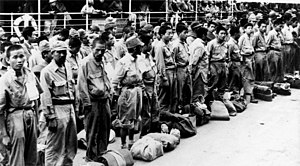
During World War II, it was estimated that between 35,000 and 50,000 members of the Imperial Japanese Armed Forces surrendered to Allied service members prior to the end of World War II in Asia in August 1945.[1] Also, Soviet troops seized and imprisoned more than half a million Japanese troops and civilians in China and other places.[2] The number of Japanese soldiers, sailors, marines, and airmen who surrendered was limited by the Japanese military indoctrinating its personnel to fight to the death, Allied combat personnel often being unwilling to take prisoners,[3] and many Japanese soldiers believing that those who surrendered would be killed by their captors.[4][5]
Western Allied governments and senior military commanders directed that Japanese POWs be treated in accordance with relevant international conventions. In practice though, many Allied soldiers were unwilling to accept the surrender of Japanese troops because of atrocities committed by the Japanese. A campaign launched in 1944 to encourage prisoner-taking was partially successful, and the number of prisoners taken increased significantly in the last year of the war.
Japanese POWs often believed that by surrendering they had broken all ties with Japan, and many provided military intelligence to the Allies. The prisoners taken by the Western Allies were held in generally good conditions in camps located in Australia, New Zealand, India and the United States. Those taken by the Soviet Union were treated harshly in work camps located in Siberia. Following the war the prisoners were repatriated to Japan, though the United States and Britain retained thousands until 1946 and 1947 respectively and the Soviet Union continued to hold hundreds of thousands of Japanese POWs until the early 1950s. The Soviet Union gradually released some POWs throughout the next few decades, but some did not return until the collapse of the Soviet Union in the 1990s, while others who had settled and started families in the Soviet Union opted to remain.[2]